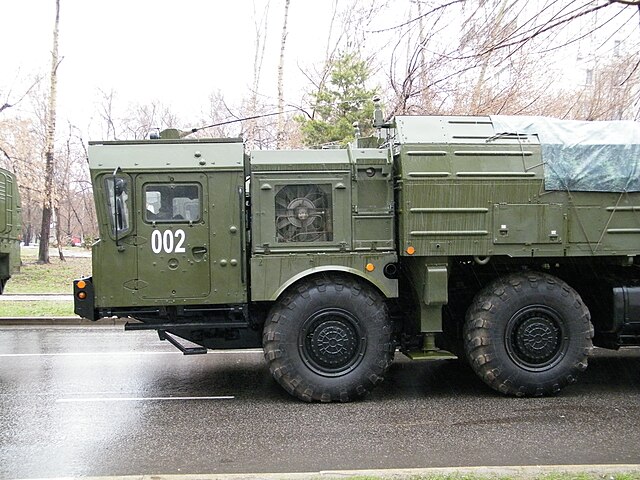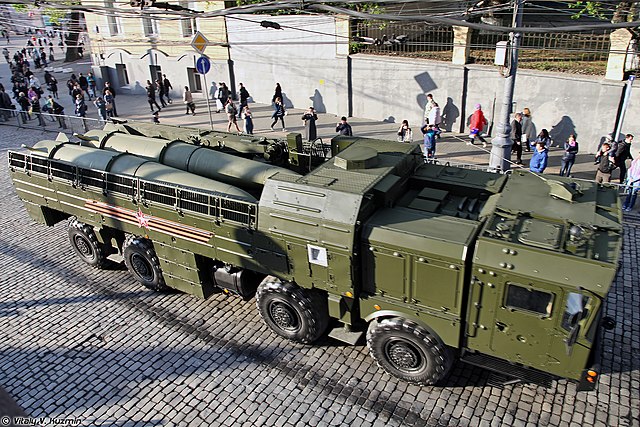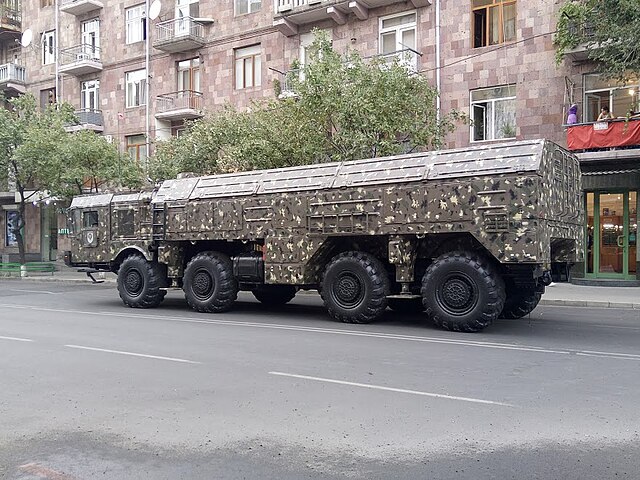9P78 TEL, 9K720 Iskander
 Russian Transporter Erector, c250 built.
Russian Transporter Erector, c250 built.
The 9K720 Iskander (NATO SS-26 Stone) is a mobile short-range ballistic missile system produced and deployed by the Russian army from 2006 and also exported. Each 9P78 TEL carried two ballistic missiles (terminal hypersonic speed Mach 7.6, 50 km alt, range 500 kilometres) each. This was the replacement for the OTR-21 Tochka but only a few were built unlike the latter. The vehicle also saw action Ukraine recently.
The Iskander complex
Development
 Iskander K in 2022
Iskander K in 2022
The need to replace the
OT-21 Tochka medium range ballistic missile transporter erector launcher (TEL). The 9K720) is a family of Russian operational-tactical missile systems with the Iskander, Iskander-M, Iskander-K, Iskander-E all developed by the research and production corp. "Design Bureau of Mechanical Engineering" (KBM) based in Kolomna, Moscow Oblast.
Its main purpose was to strike the most valuable enemy targets when covered by air defense systems at up to 500 km. It was first presented in August 1999 at the International Aviation and Space Salon (MAKS). The Iskander became the basis for the Kinzhal missile system and was developed to use a number of warheads, high-explosive fragmentation, concrete-piercing, electromagnetic pulse, or even tactical nuclear. Other were developed for specific tasks with 70 nuclear warheads in store.
In September 2017, KB Mashinostroyeniya (KBM) chief designer Valery M. Kashin declared the system was declined into seven types, including one cruise missile. The Transporter Erector Launcher assovcated was the second attempt by Russia to replace the Scud truck TELs, replacing the OTR-23 Oka, later eliminated under a reduction Treaty. Design work started by December 1988, by KBM rocket designer Sergey Nepobedimy, and considerably disturbed by the fall of USSR in 1991. Still, it was followed through and the the first successful launch was made in 1996.
In September 2004, at a meeting with senior defense officials reporting to President Vladimir Putin about the defense budget planning FY2005, MoD Sergei Ivanov reported about the successful tests of the Iskander and that production was planned to start in 2005 with a full brigade equipped by December. By March 2005, the system was further developed into a (270–320 nmi; 310–370 mi) capable evolution of the Iskander-E tactical missile.
Production of the Iskander-M system started by mid-2006, with full adoption by the Russian army between there and 2015. The production cost of was reported in 2014 to have been reduced by a third by simplification measures at each stage of the components supply chain. It was reported also that the ground-based 9M728/9M729 system was already being modernized.
In November 2016, the Russian MoD announced the Iskander-M system was ongoing, and several countries had shown interest in the export version once greenlight by early February 2017. US experts expressed concerned as for the superior range of the 9M728/9M729 (SSC-X-7/SSC-X-8), violating the INF Treaty. By April 2024 it was announced tha its accuracy had been widely improved since the start of the war in Ukraine.
Missile

The Iskander ballistic missile was to be mde superior in any way to the previous Oka. The Iskander-M (main production) is a missile comprising two solid-propellant single-stage, called the 9M723K1. Each of the two missiles carried by the TEL is controlled throughout the entire flight path and carris a single warhead. Each could be independently targeted in seconds. The mobility of the Iskander launch platform (9P78 TEL) makes its difficult to neutralized by counter battery fire.
Targets could be located via satellite data and link with aircraft and from a conventional intelligence center by artillery observer, and aerial photos scanned and computerized. They can be also re-targeted during flight so to hit mobile targets such like a ship. Another unique feature of Iskander-M is its optically guided warhead controllable by encrypted radio transmission coming from from AWACS or UAV. The electro-optical guidance system allows self-homing capability in case all communication is shut down. The on-board computer received images of the target and locks onto it by a sight until plunging on it at supersonic speed.

The missile Boost phase uses thrust vector control using graphite vanes comparable to the old V-2 and Scud but it is said capable of performing evasive maneuvers in the terminal phase as well as releasing decoys, confirmed by US analysts in at least some versions. The trajectory is still relatively flat when leaving the atmosphere, controllable by gas-dynamic and aerodynamic control surfaces in re-entry but with small fins to reduce radar signature.
The Iskander-M is hypersonic at Mach 6–7 and max 50 km. It is tactical, made to use conventional or thermonuclear warheads on moving and stationary targets with a conventional destruction capacity of 25,000 square meters (2 football fields) witn an accuracy said to be of a small window. 2007 the R-500 cruise missile was tested to reach targets at low altitude up to 2000 km or more. In 2013, brigades announced receiving a new control system. In 2018, is antiship capability was confirmed.
The Iskander, 1st version, total mass empty is 3,800 kg (8,400 lb) but the production M missile weighs 4,615 kg fully loaded with a warhead of 710–800 kg, and with a range of max 500 km (250–310 mi) at 2,000 m/s (Mach 5.9 to Mach 7) and achieves a CEP of 5–7 meters if coupled with optical homing head or 30–70 m in autonomous application as claimed.
The missile measures 7.3 m (24 ft) overall with a diameter of 0.92 m (3 ft 0 in). The Warhead range in fact really varies between 480 and 800 kg (1,060–1,600 lb) between a thermonuclear model, high-explosive (HE) fragmentation, submunition, bunker penetration, fuel–air explosive and EMP (electromagnetic pulse).
It is powered with a single-stage solid propellant and has inertial guidance with optical DSMAC for the Iskander-M and TERCOM for Iskander-K as well as GPS and GLONASS in addition with optical DSMAC for terminal homing. Accuracy on the basic 9K720 reaches up to 30 metres (98.4 feet) down to 5–7 metres
(16–23 feet) for the Iskander-M.
9P78 TEL
 Base vehicle, the МZКТ-7930
Base vehicle, the МZКТ-7930
The truck is part of the whole complex which includes six types of vehicles (51 per missile brigade):
9P78-1 TEK used for transporting, preparing and launching two missiles. Gross weight 42 tons, payload 19 tons, highway/dirt road speed 70/40 km/h, fuel range 1000 km. Crew three, based on the Chassis of the MZKT-7930. Note: There will be a dedicated article of the vehicle soon.
 Close view of the cabin
Close view of the cabin
The MZKT-7930 is a family of special wheeled chassis and tractors with a 8×8 wheel arrangement and load capacity from 17.8 to 25 tons.
The MZKT-7930 and its modifications are produced by the Minsk Wheel Tractor Plant (Belarus). It Includes the variants MZKT-7930, MZKT-7930-300 and MZKT-79306, as well as the MZKT-7415 truck tractor. The most famous application is the "Iskander", buut also the weapons systems "Bal", "Bastion", "Club-M", BSAU A-222 "Bereg", MLRS "Uragan-1M", MLRS "Polonez" and the coastal surface and air reconnaissance complex "Monolit-B", antenna posts for the S-400 "Triumph" air defense system, the RCSN Topol-M support vehicle 15V240M, the engineering support and camouflage vehicle 15M69, the heavy mechanized bridge TMM-6 and it's the base for development of the S-500 Prometheus air defense system.
⚙ 9P78 МZКТ-7930 basic chassis |
| Weights | Gross 43,3t, curb 20.8t |
| Dimensions | 12,7 x 3,07 x 3,017 m |
| Propulsion | V8 YaMZ-846 diesel 370 kw, 503 hp/2100 rpm, torque 1960 nm (200 kg/cm) |
| Transmission | GMP MZKT-5561, mechanical 6+1 Bgx |
| Suspensions | Independent, torsion bar, reinforced shock absorbers |
| Steering | Left/right steering wheel, hydraulic booster |
| Drive | Central gearboxes with center and cross-axle differentials, planetary wheel gearboxes |
| Speed | Top 70 km road. Climb 55% grade, 40 cm GC, 35 cm obstacle, 40% lat. slope |
| Range | 2×385 liters, 1000 km cruise speed |
| Armament | 2x Iskander missiles, 22t load capacity |
| Protection | None |
| Crew | 3 |
Transport-loading vehicle 9T250/9T250E:


Tansport of two spare missiles and equipped with a crane. Same MZKT-7930 chassis, 40 tons, crew 2.
Command and staff vehicle 9S552:
Based on a KAMAZ 43101 wheeled chassis with a radio station R-168-100KA “Akveduk”, crew 4. Radio range 50 km, calculation time for missiles: 10 seconds, data transmission time 15 seconds, up to 16 communication channels, deployment up to 30 minutes, continuous operation time 48 hours.
Setup and maintenance machine, MRTO:
Designed to check on-board equipment and instruments, and carry out routine repairs. Based on a KamAZ wheeled chassis. Weight 13.5 tons, deployed in 20 minutes, full automated cycle of routine checks of on-board equipment in 18 minutes, crew 2.
Information Preparation Point vehicle 9S920:
Based on a KAMAZ 43101 chassis, designed to determine target coordinates and prepare flight missions. It is interfaced with reconnaissance assets and can receive data and assigned targets from all necessary sources, satellite, aircraft or UAV. Crew 2.
Life support vehicle:
Designed for accommodation, rest and restauration of combat crews. Based on a KAMAZ 43118 wheeled chassis with a large cabin and tents with a base rest compartment and utility compartment. The rest compartment has 6 berths with folding upper beds, 2 lockers, built-in lockers, and an opening window. The utility compartment has 2 lockers with seats, a folding table, a water supply system with a 300-liter tank, a tank for heating water, a pump for pumping water, a drainage system, a sink, and a dryer for clothes and shoes.
Variants
Iskander-M
 Iskander M camouflaged, Transbaikal exercise June 2021
Iskander M camouflaged, Transbaikal exercise June 2021
Russian Armed Forces base system with two 9M723 near-ballistic missiles, range 415 km, Speed Mach 6–7, flight altitude 50 km.
Iskander-K
 Iskander-K, carrying four cruise missiles.
Iskander-K, carrying four cruise missiles.
 Iskander K at Armiya 2023 vehicle showcase
Iskander K at Armiya 2023 vehicle showcase
The "K" standard for Krylataya ("Winged") and is basically a booster for a range of cruise missiles:
-9M728 (SSC-X-7) or R-500: Flying at 6 km, 500 km range with automatic adjustment, following the terrain in flight.
-9M729 (SSC-X-8): Land-based version of the 3M14 Kalibr-NK, range 300 miles or 480 km but small enough to have 4 missiles per TEL. Higher yield warhead, improved accuracy.
Iskander-E
"E" stands for "Eksport". Rostec's CEO Sergey Chemezov announced it was nuclear capable. Prohibited for export. In 2016 it was sold anyway to Armenia, member of the Collective Security Treaty Organization, max range 280 km to comply with restrictions for export, simplified inertial guidance system. Aerodynamic steering using tail fins, fitted as standard with cluster munitions.
Operators
 Aermenian vehicle
Aermenian vehicle
 Armenia
Armenia 25 delivered, first displayed at the Independence Day parade rehearsal in September 2016. Confirmed by Rosoboronexport, four systems delivered to Armenia, first foreign state to have it. By February 2017, Armenian MoD confirmed a total of 25 delivered.
 Algeria
Algeria 4 regiments fully equipped (48 launchers). Contract signed at the Dubai Airshow 2017 exhibition, all Iskander-E delivered, confirmed by French defense writer Philippe Langloit by September–October 2017, later confirmed by Kommersant.

Belarus purchased some Iskander systems in May 2022 according to President Alexander Lukashenko. President Putin confirmed plans to give Belarus nuclear capable Iskander, and they were indeed delivered in December 2022, allegedly handed over in February 2023 to the 465th Missile Brigade with more deliveried by late August 2023.
 Russia
Russia: 160 in service, 13 rocket brigades (12 each) and one unit with 4 complexes at Kapustin Yar. Western Military District from 2010 and extra vehicles deployed in Armenia. Others stationed at Krasnodar and Stavropol territories, Republic of Adygea (49th Army, Southern Military District) and Eastern Military District from 2013. Orenburg Brigade also from 20 November 2014. 6th brigade delivered from June 2015 at Ulan Ude and 103rd Rocket Brigade. 7th brigade from November 2015, Southern Military District. 20th Separate Guards Rocket Brigade and 5th Red Banner Army, Eastern Military District in Spassk-Dalniy, Primorsky Krai from June 2016.
Contracts signed for two more brigades and cruise missiles by August 2017 for 13 scheduled. Western Military District started to received the first from late 2017 and last in the Kursk Region by November 2019, one more by late 2021. More ordered in August 2022 and August 2023 with the war in Ukraine.
Operational History
Russo-Georgian War
The first documented use: The Russo-Georgian War. When journalist Stan Storimans was killed on 12 August 2008 in Gori and investigation by the Dutch government revealed a 5 mm fragment from an anti-personnel sub-munition used by the Iskander missile. Stratfor report in 2010 confirmed five Iskander brigades at the 26th Rocket Brigade in Luga (eningrad Oblast), 92nd Rocket Brigade at Kamenka (Volga region), 103rd Rocket Brigade at Ulan-Ude (North Mongolia) and 107th Rocket Brigade at Semistochni (Far East), 114th Rocket Brigade at Znamensk (northern Caucasus).
Armenia
From June 2013 Russia had several Iskander-M confirmed in Armenia and Armenian itself received some. In November 2014, US General Breedlove commented these vehicles are "nucear capable" and had been moved into Crimea after the annexation in March. It was later confirmed by Ukraine. Russian Foreign Ministry confirmed the right to deploy nuclear weapons in the peninsula in December 2014 and again in June 2015.
Syria
In March 2016, one reportedly deployed at the Hmeimim airbase in Syria. Conformed by an Israeli satellite by January 2017. Fox News reported in 2017, four fired at opposition forces, Idlib province, Syria.
Kaliningrad enclave
In November 2008, Russian president Medvedev announced plans to deploy Iskander in the Kaliningrad Oblast. On 17 September 2009, US president Barack Obama announced the cancellation of the U.S. missile defense project in Poland and the Czech Republic for des-ecalation. After backing dow, a few days later, the decision not to deploy them was confirmed by Medvedev, but some weerz spotted in military exercises in March 2015. By 8 October 2016, their presence was conformed after all by the Russian MoD as a preventive measure for possible US deployments in Poland. It was confirmed again by February 2018, an undisclosed number of Iskander in Kaliningrad in "park zones" completed as well as in North Ossetia.
2020 Nagorno-Karabakh War
Armenia reportedly used its systems against Azerbaijani forces, from the town of Shushi after capture by Azerbaijani forces. PM Nikol Pashinyan implied that the missiles that were launched did not explode. Various claimes and counter-claims were made, but theres is no certaintly aout their use.
Ukraine 2022
The 2022 Russian invasion of Ukraine saw deployment of several Iskander units on the border as support for the assault. For the first time, decoys use to confuse Ukrainian air defense systems was confirmed. Up from 23 April 2022, more units were deployed to the Belgorod Oblast, 60 km from the border. There had been contradictory claims on vulnerability. In 29 May 2023 Ukraine claimed to have destroyed 11 Iskander missiles of the ballistic and cruise missile variants.
On 5 March 2024, one confirmed destroyed by a M142 HIMARS near Nykanorivka, Donetsk Oblast. 9 March another was conformed used to to destroy two German M901 Launchers, MIM-104 PAC-2 Mobile Patriot near Sergeevka. July, wave of attacks using Iskander missiles on Ukrainian airbases, preceded by drone recce: Myrhorod, Poltava, Krivoi Rog Air Bases with several aircraft destroyed.